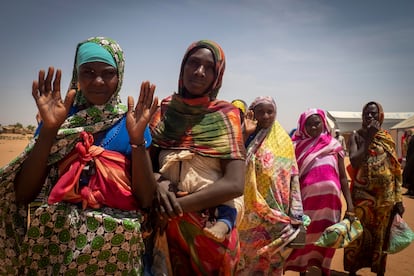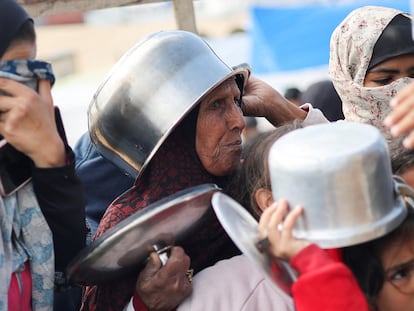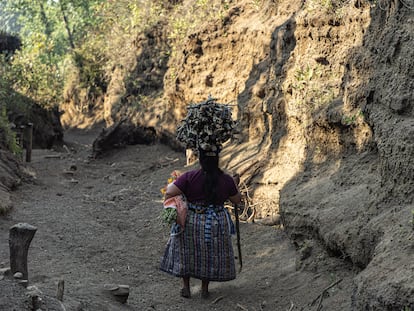The advancement of women’s rights struggles against racism and inequality
Maternal mortality and the rate of teenage pregnancies have improved globally in recent decades. However, these figures have worsened ‘in an alarming number of countries,’ according to the latest report by the United Nations Population Fund


The progress made in women’s sexual and reproductive rights has especially benefited women who are high-income, those who belong to ethnic groups that already had better access to healthcare and those who have received more education. This is the conclusion reached by the latest report published by the United Nations Population Fund (UNFPA), which was made public this past Wednesday. It confirms that millions of women and girls haven’t been able to enjoy these advances “because of who they are or where they were born.”
“In a period of a single generation, we’ve reduced unwanted pregnancies by a fifth, we’ve lowered the maternal mortality rate by a third and we’ve approved laws against sexist violence in more than 160 countries,” said Natalia Kanem — executive director of the UNFPA — during a meeting with journalists on Monday, April 15. However, she noted, “despite this progress, inequities in our societies and in our health systems have widened.”
This is because racism, sexism and other forms of discrimination continue to block the achievement of sexual and reproductive rights for millions of women in the world. Kanem warned that “women’s rights haven’t been prioritized” and, instead, their bodies have been “politicized” as a weapon to “divide” society.
The UNFPA document — Interwoven Lives, Threads of Hope: Ending Inequalities in Sexual and Reproductive Health and Rights — is published in the year that marks the 30th anniversary of the Cairo Conference on Population and Development. This was a historic moment in which 179 governments committed — for the first time — to placing women’s rights at the center of sustainable development. Since then, the figures support many of the milestones achieved: maternal mortality has fallen by 34% since 2000, while the number of girls and young women who become mothers between the ages of 15 and 19-years-old has declined by a third during the same period. And, between 1990 and 2021, the number of women using modern contraceptive methods has doubled. The number of new HIV infections was also one-third lower in 2021 than in 2010.
However, the UNFPA cautions that women and girls who are poor, who belong to racial, ethnic, or Indigenous minorities, who live in countries in conflict, who have a disability, or who don’t identify with heteronormative paradigms are hardly part of the population that has benefited.
The data supports this conclusion. For instance, an African woman with complications during pregnancy or childbirth is 130 times more likely to die than a woman in Europe or North America. But, even if she lives in the United States, if she’s Black, the statistics don’t work in her favor, either. In fact, the possibility of her losing her life is three times higher than the national average.
About 800 women die every day in childbirth around the world. 500 of these tragedies take place in countries that are embroiled in armed conflicts. Most of these deaths could be avoided with access to adequate healthcare. Meanwhile, a woman with a disability is 10 times more likely to suffer sexist violence than a woman without one, while attacks against LGBTQ+ women are also much more frequent.
Climate crisis and conflicts
Maternal mortality is, according to the UNFPA, a reflection of the “disparity” that exists between and within territories. In recent decades, in global terms, far fewer women die during pregnancy or childbirth, although the figure has stagnated since 2016 and is worsening in “an alarming number of countries.”
“Mothers die because we haven’t prioritized their reproductive rights, even though at the Cairo conference 30 years ago, it was [understood] that they didn’t have to die in childbirth,” Kanen added during her press conference. For example, according to the UNFPA, an African-American woman is more likely to suffer obstetric abuse than a white woman. And, in Madagascar, the richest women are five times more likely to be assisted during childbirth than poor women. Among the rights to be achieved, Kanen recalled that one in four women in the world still cannot say “no” to having sex with her partner and one in 10 cannot choose the contraceptive methods she wishes to use.
The situation is even more dire in conflicts and in contexts of climate catastrophes, which are becoming more frequent because of global warming. “These are situations that leave women without healthcare,” Kenan lamented. “Whenever there are hurricanes or floods, for example, women and children are — without exception — the most disadvantaged.” The executive director of UNFPA emphasized that it’s the responsibility of the international community to ensure that, in a crisis, women can give birth safely and be protected from sexual violence. “The vulnerability of women in conflict is enormous: attacks against them are increasing.” And, at the same time, she denounced that “health workers and healthcare centers have become targets of war.”
“Women are being attacked in much of the world,” agreed Tlaleng Mofokeng — one of the authors of the report — during the meeting with journalists. “There are systems that seek to take away their rights or limit their participation in activism,” the researcher added. She advocates for “making the invisible visible” to continue putting the defense of women at the center of development.
According to the UNFPA, greater investment is the solution to bolstering women’s rights. “These investments would also generate significant economic benefits,” Kanen explained. For example, spending $79 billion on family planning and maternal health at the global level would save “one million women” from dying in childbirth by 2050. This, in turn, would mean economic benefits worth about $660 billion.
Ending sexist violence — which the U.N. estimates costs the world economy 5% of overall GDP — “would result in immediate and long-term benefits for individual productivity and earning potential with impacts cascading across generations,” the report adds. Furthermore, Kanen pointed out, “promoting gender equality in the public, private and social sectors” would add about “$12 trillion” to global GDP.
Translated by Avik Jain Chatlani.
Sign up for our weekly newsletter to get more English-language news coverage from EL PAÍS USA Edition
Tu suscripción se está usando en otro dispositivo
¿Quieres añadir otro usuario a tu suscripción?
Si continúas leyendo en este dispositivo, no se podrá leer en el otro.
FlechaTu suscripción se está usando en otro dispositivo y solo puedes acceder a EL PAÍS desde un dispositivo a la vez.
Si quieres compartir tu cuenta, cambia tu suscripción a la modalidad Premium, así podrás añadir otro usuario. Cada uno accederá con su propia cuenta de email, lo que os permitirá personalizar vuestra experiencia en EL PAÍS.
¿Tienes una suscripción de empresa? Accede aquí para contratar más cuentas.
En el caso de no saber quién está usando tu cuenta, te recomendamos cambiar tu contraseña aquí.
Si decides continuar compartiendo tu cuenta, este mensaje se mostrará en tu dispositivo y en el de la otra persona que está usando tu cuenta de forma indefinida, afectando a tu experiencia de lectura. Puedes consultar aquí los términos y condiciones de la suscripción digital.
More information
Archived In
Últimas noticias
Most viewed
- Reinhard Genzel, Nobel laureate in physics: ‘One-minute videos will never give you the truth’
- Oona Chaplin: ‘I told James Cameron that I was living in a treehouse and starting a permaculture project with a friend’
- Pablo Escobar’s hippos: A serious environmental problem, 40 years on
- Chevy Chase, the beloved comedian who was a monster off camera: ‘Not everyone hated him, just the people who’ve worked with him’
- Why we lost the habit of sleeping in two segments and how that changed our sense of time










































